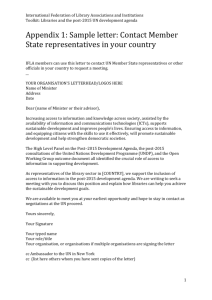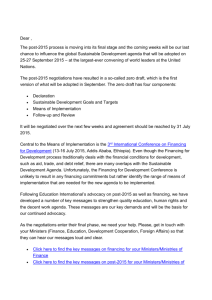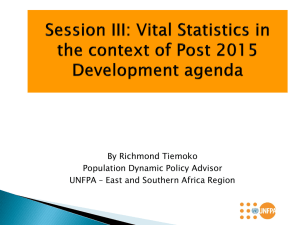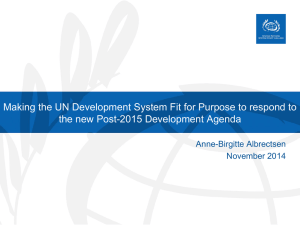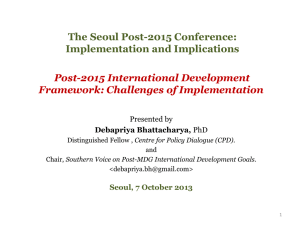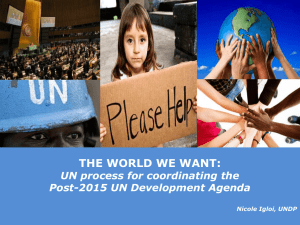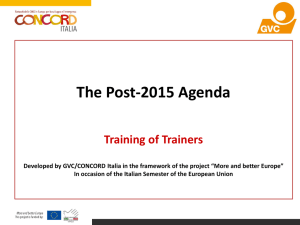September 2014
advertisement
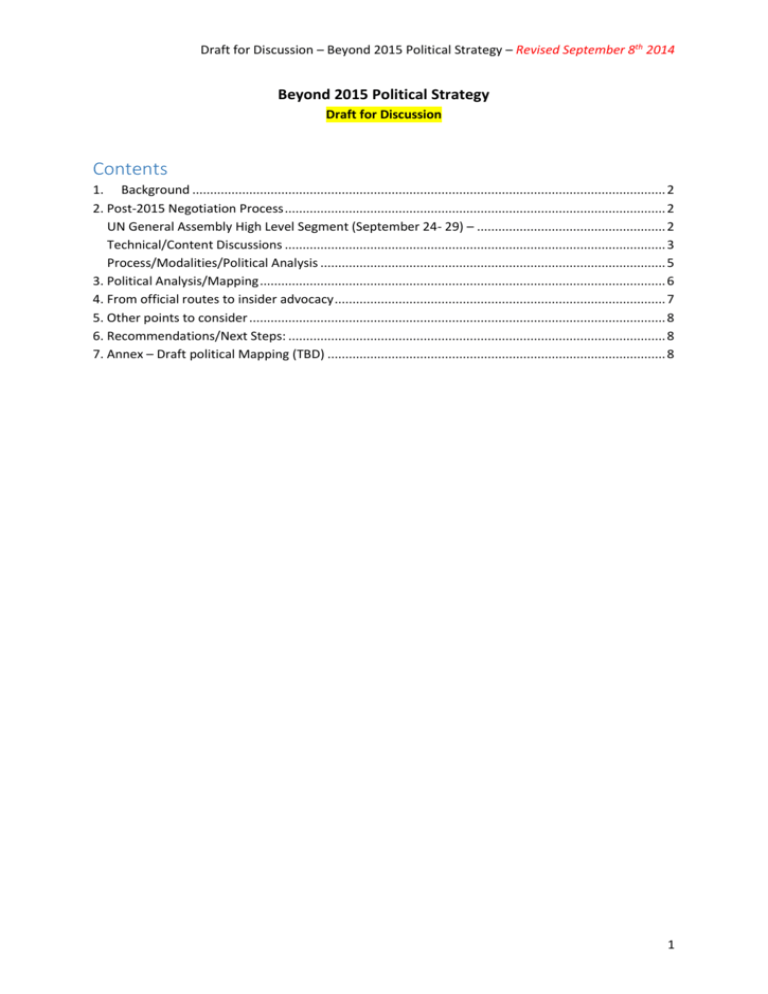
Draft for Discussion – Beyond 2015 Political Strategy – Revised September 8th 2014 Beyond 2015 Political Strategy Draft for Discussion Contents 1. Background ..................................................................................................................................... 2 2. Post-2015 Negotiation Process ........................................................................................................... 2 UN General Assembly High Level Segment (September 24- 29) – ..................................................... 2 Technical/Content Discussions ........................................................................................................... 3 Process/Modalities/Political Analysis ................................................................................................. 5 3. Political Analysis/Mapping .................................................................................................................. 6 4. From official routes to insider advocacy ............................................................................................. 7 5. Other points to consider ..................................................................................................................... 8 6. Recommendations/Next Steps: .......................................................................................................... 8 7. Annex – Draft political Mapping (TBD) ............................................................................................... 8 1 Draft for Discussion – Beyond 2015 Political Strategy – Revised September 8th 2014 Beyond 2015 Political Strategy Draft for Discussion 1. Background This draft document intends to guide Beyond 2015 political work from September 2014-2015 based on some key elements of the discussions: The final outcome of the OWG SDG and the consensus agreement (although with voiced concerns from Member States) around the Goals and Targets. The 2014 UN GA High Level Segment and the new President of the General Assembly (September 2014). The forthcoming negotiation modalities resolution (October/November 2014 – TBC) The forthcoming synthesis report of the UN Secretary-General (Nov/Dec 2014 - TBC) The role of the regional and country levels in shaping country positions before the intergovernmental negotiations re-start in New York and in following up the discussions. The importance of discussions around participation and the accountability of the post-2015 framework. This document is intended to provide guidance to Beyond 2015 Executive Committee, Secretariat and other structures of the Campaign, including Regional coordinators, National leads and the UN Working Group and will remain open and flexible to adaptations as the post-2105 negotiation process is defined and evolves. This document may also be opened to the whole campaign and wider partner community. This is a crucial moment for the campaign and for the post-2015 process when the window of opportunity to make proposals may be closing and there is no clarity about how civil society will engage in the official inter-governmental negotiations. This is the time to analyse what has been proposed so far and to have clarity about the key messages the Campaign will be delivering from now until the adoption of the new framework. 2. Post-2015 Negotiation Process As of September 2014, the inter-governmental aspects of the post-2015 negotiation process is still unclear and will depend on decisions to be taken by the new President of the General Assembly (Sam Kutesa, Uganda). Some milestones should be considered by Beyond 2015: UN General Assembly High Level Segment (September 24- 29) – Differently from last year, this UN GA will have other topics under discussion and will not focus mainly on the post-2015 agenda. However, since the PGA of the 69th Session proposed the theme to be “Delivering on and Implementing a Transformative Post-2015 Development Agenda” it is expected that Heads of State and other Senior representatives will include references to the post2015 negotiations in their statements. This will be a period for Members of Beyond 2015 attending 2 Draft for Discussion – Beyond 2015 Political Strategy – Revised September 8th 2014 the UNGA week to engage in discussions with Member States and try to get intel to support strategic discussions within the campaign. Technical/Content Discussions Beyond 2015 reaction to the OWG outcome – A Beyond 2015 Task Force was set up to draft the Campaign’s reaction/comments to the Outcomes of the OWG SDG. Some points considered: o Careful not to trash the entire document, highlighted the positive aspects and what needs to improve and, at the same time, pushing for more. o The OWG document should be considered the “floor” not the “ceiling” for the forthcoming negotiations. Call for “improving” the language is key and, at the same time, push for more. o Beyond 2015 to define a position on discussions around the number of Goals and Targets. o If the Campaign encourages the forthcoming intergovernmental negotiations to focus on the substance and number of Goals and Targets, it should also make clear recommendations on when, where and how other important issues around financing, institutional architecture, and MOI are agreed. Important point to make – ask for clear references that no target will be considered met unless met for all. The Task Force will produce the following documents (i) (FINALIZED) A Summary with key comments from Beyond 2015. This document will be the basis for the Campaigns advocacy work around the UNGA High Level Segment and the PGA Stocktaking Event (11-12 September) and Civil Society hearing (September 10). (ii) (UNDER DEVELOPMENT) A compilation of expert comments to the Goals and Targets focusing on what is positive, what needs improvement and what is missing. (iii) (UNDER DEVELOPMENT) A Sub-Group is working on a paper on “Accountability”, a key point in the forthcoming negotiations. UN Secretary General’s synthesis report (End of November/Beginning of December) This will probably be the last chance for the Secretary-General to influence the negotiations of the post-2015 framework. We know that Amina Mohammed’s office will lead the drafting of this report with support of some other key players in New York (Paul Ladd (UNDP); UN DESA (?). Amina had suggested streamlining or consolidating the goals but this met with strong pushback from missions in NY. As a synthesis report, it will be “short” - around 20 pages, 9,500 words considering the previous reports - with the following proposed chapters: (1) background; (2) the Goals and targets (based on the OWG SDG); (3) Financing and Means of Implementation (based on the inter-governmental discussions) and (4) Accountability framework (based on the Accountability Dialogues to be organized by the UN Regional Commissions). There is some appetite for leveraging the opportunity (e.g Helen Clark, Amina Mohammed are still pushing for SG to refine the goals/targets) although temperature checks currently indicate that 3 Draft for Discussion – Beyond 2015 Political Strategy – Revised September 8th 2014 the SG should de-link from streamlining agenda through his report (to avoid legitimacy issues). Discussions around the “implementability” of the agenda still remain and may gain momentum as the content is defined. The discussion on the accountability of the post-2015 framework itself is particularly important for Beyond 2015 and a theme that has not been covered by the inter-governmental discussions yet (at least not by the OWG SDG). Inclusiveness and meaningful participation of civil society in the drafting, implementation and monitoring of the post-2015 agenda is crucial. The High Level Political Forum (HLPF) is expected to be the institutional “home” of the SDGs and responsible for the accountability of the new framework. This will need to be clearer in the intergovernmental negotiations. The HLPF so far has no Secretariat to support it and the civil society engagement has been very weak – in part because of lack of clear communication from the UN and the current ECOSOC president (Austria) who does not value CS participation. Beyond 2015 to use the OWG reaction as a basis for a letter to Amina Mohammed as the Campaign’s contribution to the SG report Organize briefings at national level and in NY to present Beyond 2015 comments to the synthesis report). Beyond 2015 to maintain and strengthen relationships with key UN partners in NY that are working in this and other Post-2015 documents (Advocacy Director and UN WG to take the lead) Beyond 2015 to engage with the HLPF process, possibly through a Task Force. Regional Consultations and the Role of UN Regional Commissions The draft Summit modalities resolution included a call for UN Regional Commissions to organize events in preparation for the Post-2015. Through its global structure, Beyond 2015 is well placed to engage in the regional consultations, particularly with pre-existing regional positions. Beyond 2015 to gather information on the role of the regional commissions and who is driving this part of the process. Beyond 2015 Regional Coordinators to establish contact with UN Regional Commissions early on to be included in invitation lists when meetings are organized. To be discussed: What will be the role of the UN Regional Commissions in the Post-2015 negotiation process? Will they support in shaping regional positions? How open are they to civil society participation? Third International Financing for Development Conference, July 2015, Addis Ababa The third UN FfD conference (following on from Monterrey 2002 and Doha 2008) has been set for 13 – 16 July 2015. The mandate is to reinforce coherence and coordination, avoid duplication of FfD process, with a view to ensuring a single, comprehensive approach. The date of the conference (before the post-2015 framework is agreed) is considered a victory for the G77, providing them with an opportunity to force financing into the discussions in advance of the post-2015 agreement. The conference calls for highest level of participation. All negotiations of the outcome document will take place at the UNHQ in NY, with ‘informal consultations and drafting sessions’ for 3 days in January, 5 days in April, and 5 days in June. The President of the General Assembly appointed Norway (Geir Pedersen) and Guyana (Ambassador George Talbot) as Co-Facilitators of this negotiation process. 4 Draft for Discussion – Beyond 2015 Political Strategy – Revised September 8th 2014 The scheduling of the Conference, late in the negotiation process, means little will be agreed before this is concluded and that there is desire to do what it takes to ensure we avoid perception of “failed FfD” due to implications for Post-2015 agreement. The modalities resolution for this Conference affirms that its outcome document should constitute an important contribution to and support the implementation of the post-2015 agenda: Beyond 2015 to appoint focal points to follow this topic and to keep the Ex Com and the Secretariat informed on the implications of this debate on the Post-2015 negotiations. Beyond 2015 to track the financing for development discussions and to build relationships with trusted partners/coalitions to help coordinate/reinforce messages across both forums Beyond 2015 needs to have a sense of what constitutes a “win” for LDCs, LICs, MICs and HICs. Discuss within the Executive Committee and/or UNWG potential risks the financing debate presents to the creation and agreement of an ambitious post-2015 framework. Process/Modalities/Political Analysis Although we still need to engage in CSO consultations and networks, now we should focus on collaborative advocacy, considering that at country level we must now deal with both Foreign Affairs and Planning and Finance Ministries. In New York, Permanent Representatives (PR) and Deputy Permanent Representatives (DPRs) may engage more in the next phase of discussions. Apparently, DPRs engaged in the MDGs Summits in 2005 and 2010. New President of the General Assembly (PGA)- Sam Kutesa, Uganda The new PGA will play an important role in bringing these processes together. It is still unclear how Mr. Kutesa will engage with civil society. A letter from Beyond 2015 to the new PGA was sent later in June. The topic he has chosen for the general debate is “Delivering on and Implementing a Transformative Post-2015 Development Agenda”. Initial signs from Uganda regarding CSO engagement are not promising as this one of the countries asking for CSOs to be removed from the OWG discussions. Although as the PGA, Uganda will not be expected to hold a position and only facilitate the process, the Common African Position may have increased weight in framing discussions . Beyond 2015 to establish direct contacts with Mr. Kutesa and his office. Beyond 2015 has invited Ambassador Kutesa to the Beyond 2015 Copenhagen Conference to be held in November 14. Modalities Resolutions o Summit Modalities: Negotiations on the modalities resolution for the Post-2015 Summit are being facilitated by the Permanent Representatives of Denmark and Papua New Guinea. The draft resolution includes references to the participation of civil society organizations in some specific moments of the discussions. o Negotiation Modalities - The new PGA is expected to nominate two additional facilitators to lead the negotiations modalities for the post-2015 process. Those two facilitators may become the Co-Chairs of the Post-2015 negotiations although it is still early to say so. Crucial negotiation to follow up (probably October/December 2014) as it will set out the specifics for the inter-governmental negotiations. 5 Draft for Discussion – Beyond 2015 Political Strategy – Revised September 8th 2014 Beyond 2015 to follow the discussions and negotiations around the “negotiation modalities” resolution and to try to influence for a strong participation of civil society in the process. Beyond 2015 to make direct links with the two co-facilitators of the negotiation modalities, once they are appointed. Civil Society hearings The Post-2015 Summit modalities resolution also foresee the organization of a civil society hearing (TBC – April 2015, New York). Although important this is not enough as we need to guarantee that civil society will have access to the official inter-governmental negotiations. 3. Political Analysis/Mapping To be reviewed– What type of mapping/analysis do we want to make? In the run up to the final negotiations it is important to focus on the country level, with strong coordination mechanisms across the Campaign so that our interventions have impact. However, when the negotiations start (probably earlier in January) we will need all hands on deck, both in NY and at the national and regional level. As there is no ‘one size fits all’, we should adopt different strategies which include: o Engaging through national civil society. This will be most effective where there are strong Lead Agencies, existing civil society/government relationships, and governments who are open to listening to and engaging with civil society actors. o Engaging through regional mechanisms. When national governments are unresponsive to pressure from civil society, influence can be leveraged through regional mechanisms and processes, which can prompt governments to shift their position. o Engaging directly with Missions based in New York. Some countries have weak Capital/Mission links, and in this instance it is more effective to engage with the Mission directly. This can also be the case if there is limited space for civil society in the national context. Due to the global structure of Beyond 2015, the Campaign is well placed to employ these different structures. A cohort of strong Lead Agencies guide our work at the national level; good regional coordination means that we are able to engage regionally; and expert NY links, with the collaboration and support of the UNWG, enable the global Campaign to be channelled to the right people at the right time at the UN. Our challenge now is to leverage this structure throughout the final 12 months – this period will be the most crucial for delivering a global development framework that meets the objective of delivering tangible change on the ground for the people who need it most, and putting the world on a pathway of sustainable development. 6 Draft for Discussion – Beyond 2015 Political Strategy – Revised September 8th 2014 The type of mapping may vary depending on the structure defined by the negotiation process. A EU X G77 type of negotiations would entail a different mapping and approach than a “OWG-like” troika approach. Suggestions (To be defined also considering the capacities within the Campaign): - An analysis combining blocs + with mission/capital linkages; - Interconnections between blocs and countries; - Thematic/issue based bloc analysis; - Matrix/Map high influence x High importance Analysis of Blocs - G77 - African Group - EU - SIDS - Arab Group - LDCs - SADC - ALBA - BRICS - Others? Analysis of Key Countries per region Focus on the positions of countries that are more influential in the Post-2015 negotiation process. Cross-reference with analysis made for the Supportive States work. Analysis of Capital X New York Levels: The connection with capitals and representatives based in UN missions will continue to be essential. There is no ‘one size fits all’ approach, because while some governments have well-resourced teams with good communication, others, particularly from developing countries, will have fewer human resources. Understanding the set-up and context will be key. Effective missions also often depend on influential individuals, who are well known and respected, but this can be disconnected from the size of the mission. Formal and informal relationship building with decision makers is key, and developing informal relationships should be built into the strategy. 4. From official routes to insider advocacy Since the negotiation modalities will only be discussed after the new PGA starts in office (Sept 16), it is very unclear what type of engagement will be allowed for civil society in the intergovernmental process. Considering this, it will become necessary for Beyond 2015 to leverage the relationships it has developed with decision-makers, power brokers and influencers both within the UN system and in key governments to impact upon the post-2015 agenda. 7 Draft for Discussion – Beyond 2015 Political Strategy – Revised September 8th 2014 The first focus for the inter-governmental process will be on the negotiating modalities. Beyond 2015 will follow up and influence (see above). The discussion on substance is expected to start early in 2015. The period before the inter-governmental negotiations re-start will be crucial for the engagement at regional and national levels and to try to influence governments before they reengage in the negotiations in New York again. There may also be a small window while the negotiations focus on modalities and before the focus on substance and content begins again. Tactical trade-offs and technical amends will run right through to September 2015, particularly given that scheduling of FfD Conference (July) will mean little “agreed” until after that. 5. Other points to consider a) b) c) d) What are the priority themes that Beyond 2015 should prioritize moving forward? 5 key bets we would make for next 12 months What will help move the process forward in the right direction (regarding our values) What might block the process and the agreement of a transformative agenda (with relation to our values? e) How could we assess and approach the different blocs, like the G77, EU, etc? f) Which countries are we prioritising and why (39 priority countries in which we have lead agencies)? Are there others we should look to prioritise? g) Light mapping of priority countries against our key values – Mapping efforts should consider the internal capacity within the Campaign h) Who from Ex Com is leading on what i) How the results of our work at the national level should best be used to influence decisions which are taken in NY, and how our work at the national level is guided by the global political process – noting that activity at the country level needs to be strategic and genuinely needs to influence the post-2015 process, as people (governments and civil society) seem to have post-2015 fatigue. To combat this, we may need to look beyond the ‘event centred’ advocacy calendar. What is the level of ambition that we expect to see – Is agreed language enough? Is the OWG outcome the floor or the ceiling? What is the campaign’s position regarding debates around the number of Goals and targets? What does success looks like? 6. Recommendations/Next Steps: Below follows some specific recommendations/next steps to be reviewed by Beyond 2015 Executive Committee: 1) Decide on the priority themes and areas for the campaign –(Consider the results of the survey with participating organisations?) 2) Carry out mapping (definition of format, based on the priority themes and capacity available) 3) Agree the 5 key bets- These can feed into indicators for success 7. Annex – Draft political Mapping (TBD) 8
